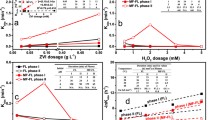Abstract
Fe nanochains with diameters of 50–150 nm and average length of about 1 μm were synthesized by titrating NaBH4 solution into FeCl2 aqueous solution (i.e., reduction of Fe(II) ions). The microstructures and magnetic properties were studied by X-ray diffraction (XRD), transmission electron microscope (TEM), and vibrating sample magnetometer (VSM). The results reveal that the nanochains have a core–shell structure with α-Fe as the core and amorphous iron oxide as the shell. The Fe core–shell nanochains show the characteristic of soft magnetic materials, achieving the highest magnetization of 200.74 mA·m2·g−1. The influences of the titrating rate of NaBH4 aqueous solution on the morphology of the Fe nanochains were also studied. It reveals that low titrating rate is beneficial for synthesizing Fe nanochains with uniform morphology. The reduction experiments indicate that these Fe nanochains are of high reducibility. About 90 % Cr(VI) ions are successfully removed after 10 min reaction of 100 mg Fe nanochains in the 100 ml K2Cr2O7 solution (100 mg·L−1) and more than 99 % after 30 min.





Similar content being viewed by others
References
Rao CNR, Cheetham AK. Science and technology of nanomaterials: current status and future prospects. J Mater Chem. 2007;11(17):2887.
Zhang D, Du X, Shi L, Gao R. Shape-controlled synthesis and catalytic application of ceria nanomaterials. Dalton Trans. 2012;41(48):14455.
Huber DL. Synthesis, properties, and applications of iron nanoparticles. Small. 2005;1(5):482.
Chicgoua N. Metallic iron for water treatment: a critical review. Clean-Soil, Air Water. 2013;41(7):702.
El-Temsah YS, Joner EJ. Ecotoxicological effects on earthworms of fresh and aged nano-sized zero-valent iron (NZVI) in soil. Chemosphere. 2012;89(1):76.
Osipov AV, Iakubov IT, Lagarkov AN, Maklakov SA, Petrov DA, Rozanov KN, Ryzhikov IA. Multi-layered Fe films for microwave applications. Piers Online. 2007;3(8):1303.
Djekoun A, Boudinar N, Chebli A, Otmani A, Benabdeslem M, Bouzabata B, Greneche JM. Characterization of Fe and Fe50Ni50 ultrafine nanoparticles synthesized by inert gas-condensation method. Phys B. 2009;404(20):3824.
Dai L. Behavior of Fe powder during high-energy ball milling cooperated with dielectric barrier discharge plasma. Acta Metall Sin (Engl Lett). 2013;26(1):63.
Walker JC, Saranu SR, Kean AH, Wood RJK. Fe nano-particle coatings for high temperature wear resistance. Wear. 2011;271(9–10):2067.
Ahmadabadi MN, Shirazi H, Ghasemi-Nanesa H, Nedjad SH, Poorganji B, Furuhara T. Role of severe plastic deformation on the formation of nanograins and nano-sized precipitates in Fe-Ni-Mn steel. Mater Des. 2011;32(6):3526.
Zea H, Luhrs CC, Phillips J. Reductive/expansion synthesis of zero valent submicron and nanometal particles. J Mater Res. 2011;26(5):672.
Cui ZL, Dong LF, Hao CC. Microstructure and magnetic property of nano-Fe particles prepared by hydrogen arc plasma. Mater Sci Eng A. 2000;286(1):205.
Griffiths CH, O’Horo MP, Smith TW. The structure, magnetic characterization, and oxidation of colloidal iron dispersions. J Appl Phys. 1979;50(11):7108.
Sun YP, Li XQ, Cao J, Zhang WX, Wang HP. Characterization of zero-valent iron nanoparticles. Adv Colloid Interface Sci. 2006;120(1–3):47.
Natter H, Hempelmann MR. Nanocrystalline metals prepared by electrodeposition. Z Phys Chem. 2008;222(2–3):319.
Zhu YC, Zhao JZ, Zhou B, Zhao X, Wang ZC. Preparation of metallic iron nanoparticles with liquid phase chemical reduction method. Chem J Chin Univ-Chin. 2008;29(10):2020.
Santos A, Ardisson JD, Viegas ADC, Schmidt JE, Persiano AIC, Macedo WAA. Structure and magnetism of granular Fe–Al.2O3. J Magn Magn Mater. 2001;226–230(2):1861.
O’Connor CJ, Kolesnichenko V, Carpenter E, Sangregorio C, Zhou W, Kumbhar A, Simsa J, Agnoli F. Fabrication and properties of magnetic particles with nanometer dimensions. Synth Met. 2001;122(3):547.
Alivisatos AP. Naturally aligned nanocrystals. Science. 2000;289(5480):736.
Acknowledgments
This work was financially supported by the National Natural Science Foundation of China (No. 51201004), the Research Fund for the Doctoral Program of Higher Education of China (No. 20121102120002), and the Fundamental Research Funds for the Central Universities (No. YWF-13-ZY–045).
Author information
Authors and Affiliations
Corresponding author
Rights and permissions
About this article
Cite this article
Feng, HF., Yu, YX., Jiang, SQ. et al. Synthesis of magnetic core–shell iron nanochains for potential applications in Cr(VI) ion pollution treatment. Rare Met. 40, 176–179 (2021). https://doi.org/10.1007/s12598-014-0408-y
Received:
Revised:
Accepted:
Published:
Issue Date:
DOI: https://doi.org/10.1007/s12598-014-0408-y




